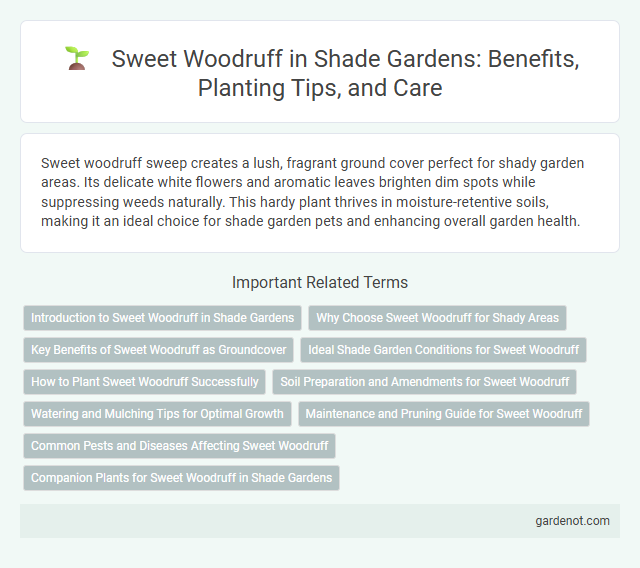Sweet woodruff sweep creates a lush, fragrant ground cover perfect for shady garden areas. Its delicate white flowers and aromatic leaves brighten dim spots while suppressing weeds naturally. This hardy plant thrives in moisture-retentive soils, making it an ideal choice for shade garden pets and enhancing overall garden health.
Introduction to Sweet Woodruff in Shade Gardens
Sweet woodruff (Galium odoratum) thrives in shade gardens, offering a fragrant groundcover with soft, whorled leaves and delicate white star-shaped flowers. It naturally spreads to form lush mats under trees and shrubs, improving soil health by preventing erosion and maintaining moisture. This low-maintenance perennial is ideal for adding texture and seasonal interest in shaded areas, especially in USDA zones 4 to 8.
Why Choose Sweet Woodruff for Shady Areas
Sweet woodruff thrives in shaded garden areas due to its exceptional shade tolerance and ability to form dense ground cover, suppressing weeds effectively. Its delicate white flowers and aromatic foliage add both visual appeal and a pleasant scent, enhancing the ambiance of low-light environments. The plant's low-maintenance nature and adaptability to various soil types make it an ideal choice for shaded gardens requiring sustainable and attractive ground coverage.
Key Benefits of Sweet Woodruff as Groundcover
Sweet woodruff provides an evergreen, dense carpet ideal for shady garden areas, effectively suppressing weeds while requiring minimal maintenance. Its fragrant white flowers attract pollinators, enhancing biodiversity in shaded ecosystems. This groundcover's tolerance to poor soil and moisture variations makes it a resilient and aesthetically pleasing choice for shade gardens.
Ideal Shade Garden Conditions for Sweet Woodruff
Sweet Woodruff thrives in moist, well-drained soil with rich organic matter, making it an excellent ground cover for shaded garden areas. It prefers partial to full shade, where indirect sunlight helps maintain its vibrant green foliage and delicate white flowers. Ideal conditions include consistently cool temperatures and protection from harsh afternoon sun to prevent leaf scorch and promote dense growth.
How to Plant Sweet Woodruff Successfully
Plant Sweet Woodruff in well-drained, humus-rich soil with partial to full shade exposure to mimic its natural woodland habitat. Space plants about 12 inches apart to allow a dense groundcover and water consistently to keep the soil moist but not waterlogged. Mulching around the plants helps retain moisture and regulate soil temperature, promoting healthy growth.
Soil Preparation and Amendments for Sweet Woodruff
Sweet woodruff thrives in well-drained, moist, and humus-rich soil, making soil preparation crucial for its healthy growth. Incorporate organic matter such as compost or leaf mold to enhance soil fertility and structure while maintaining a slightly acidic to neutral pH level between 5.5 and 7.0. Regularly mulching with organic materials helps retain moisture, suppress weeds, and stabilize soil temperature in shade garden environments where sweet woodruff is planted.
Watering and Mulching Tips for Optimal Growth
Sweet woodruff (Galium odoratum) thrives in consistently moist, well-drained soil, making regular watering essential during dry spells to prevent stress and promote lush growth in shade gardens. Applying a 2-3 inch layer of organic mulch, such as shredded bark or leaf mold, helps retain soil moisture, regulate temperature, and suppress weeds, fostering an optimal environment for root development. Maintaining hydrated soil with proper mulching enhances the plant's fragrance and carpet-like foliage, ensuring vigorous and healthy ground cover.
Maintenance and Pruning Guide for Sweet Woodruff
Sweet woodruff (Galium odoratum) thrives in shaded garden areas with minimal maintenance, requiring occasional watering to keep the soil moist but not waterlogged. Pruning involves cutting back the foliage after flowering in late spring to encourage fresh growth and maintain a tidy appearance. Regular removal of dead or damaged leaves prevents disease and promotes a dense, healthy ground cover.
Common Pests and Diseases Affecting Sweet Woodruff
Sweet woodruff (Galium odoratum) is susceptible to common garden pests such as slugs and aphids, which can cause leaf damage and hinder growth. Fungal diseases like powdery mildew and root rot may also affect sweet woodruff, especially in poorly drained soils or excessively humid conditions. Maintaining well-drained soil and monitoring pest activity can help prevent these issues and ensure healthy growth in shade gardens.
Companion Plants for Sweet Woodruff in Shade Gardens
Sweet woodruff (Galium odoratum) thrives in shade gardens alongside ferns, hostas, and astilbes, which complement its low-growing, fragrant foliage. Companion plants like bleeding hearts and hellebores enhance the woodland aesthetic while sharing similar light and moisture requirements. These plants collectively create a lush, textured understory that supports pollinators and promotes healthy soil conditions in shaded environments.
Sweet woodruff sweep Infographic

 gardenot.com
gardenot.com